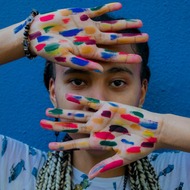
(View Complete Item Description)
Inspired by James Brown and the Black Panthers, the Black Resurgents are one of the dance crews who pioneered Oakland's boogaloo dance, the foundation of many other funk styles. However, their cultural contributions are little-known outside of the Bay. Meet these veteran dancers passing on their tradition to a new a generation, bridging the gap between boogaloo, pop-locking and turf dancing.
Oakland, California, home to the Black Panthers, also birthed the pioneering funk-driven freestyle dance Oakland Boogaloo, characterized by strong hits and poses. In the late 1960s and 1970s, before the emergence of hip hop, the city’s African American youth took inspiration from James Brown, the Temptations, Charlie Chaplin, cartoon characters, and sci-fi robots, and created a repertoire of original moves like the “Dime Stop,” the “Hit, the “Mack Pose” and “the Ditallion.” Youth in nearby San Francisco and Richmond soon developed variants of boogaloo, respectively known as strutting and robotting. Today, these techniques are collectively known as “the funk styles,” owing to their development during the funk era. Despite its pioneering status, Oakland boogaloo’s cultural contributions are little-known outside of Bay Area dance circles.
Material Type:
Activity/Lab
Author:
PBS Learning Media




















